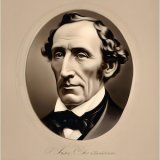The Goloshes of Fortune
"The Goloshes of Fortune" is a magical and whimsical tale by Hans Christian Andersen. It tells the story of a pair of magical boots that grant the wearer's deepest desires, taking them on unpredictable adventures. The book explores themes of desire, contentment, and the notion that the grass isn’t always greener on the other side. It's a delightful story reminding us to appreciate what we have, as our hasty wishes may lead to unexpected consequences.
Genre: Children
Genre: Children
- 18 Views
A BEGINNING In a house in Copenhagen, not far from the king's new market, a very large party had assembled, the host and his family expecting, no doubt, to receive invitations in return. One half of the company were already seated at the card-tables, the other half seemed to be waiting the result of their hostess's question, "Well, how shall we amuse ourselves?" Conversation followed, which, after a while, began to prove very entertaining. Among other subjects, it turned upon the events of the middle ages, which some persons maintained were more full of interest than our own times. Counsellor Knapp defended this opinion so warmly that the lady of the house immediately went over to his side, and both exclaimed against Oersted's Essays on Ancient and Modern Times, in which the preference is given to our own. The counsellor considered the times of the Danish king, Hans, as the noblest and happiest. The conversation on this topic was only interrupted for a moment by the arrival of a newspaper, which did not, however, contain much worth reading, and while it is still going on we will pay a visit to the ante-room, in which cloaks, sticks, and goloshes were carefully placed. Here sat two maidens, one young, and the other old, as if they had come and were waiting to accompany their mistresses home; but on looking at them more closely, it could easily be seen that they were no common servants. Their shapes were too graceful, their complexions too delicate, and the cut of their dresses much too elegant. They were two fairies. The younger was not Fortune herself, but the chambermaid of one of Fortune's attendants, who carries about her more trifling gifts. The elder one, who was named Care, looked rather gloomy; she always goes about to perform her own business in person; for then she knows it is properly done. They were telling each other where they had been during the day. The messenger of Fortune had only transacted a few unimportant matters; for instance, she had preserved a new bonnet from a shower of rain, and obtained for an honest man a bow from a titled nobody, and so on; but she had something extraordinary to relate, after all. "I must tell you," said she, "that to-day is my birthday; and in honor of it I have been intrusted with a pair of goloshes, to introduce amongst mankind. These goloshes have the property of making every one who puts them on imagine himself in any place he wishes, or that he exists at any period. Every wish is fulfilled at the moment it is expressed, so that for once mankind have the chance of being happy." "No," replied Care; "you may depend upon it that whoever puts on those goloshes will be very unhappy, and bless the moment in which he can get rid of them." "What are you thinking of?" replied the other. "Now see; I will place them by the door; some one will take them instead of his own, and he will be the happy man." This was the end of their conversation. WHAT HAPPENED TO THE COUNSELLOR It was late when Counsellor Knapp, lost in thought about the times of King Hans, desired to return home; and fate so ordered it that he put on the goloshes of Fortune instead of his own, and walked out into the East Street. Through the magic power of the goloshes, he was at once carried back three hundred years, to the times of King Hans, for which he had been longing when he put them on. Therefore he immediately set his foot into the mud and mire of the street, which in those days possessed no pavement. "Why, this is horrible; how dreadfully dirty it is!" said the counsellor; "and the whole pavement has vanished, and the lamps are all out." The moon had not yet risen high enough to penetrate the thick foggy air, and all the objects around him were confused together in the darkness. At the nearest corner, a lamp hung before a picture of the Madonna; but the light it gave was almost useless, for he only perceived it when he came quite close and his eyes fell on the painted figures of the Mother and Child. "That is most likely a museum of art," thought he, "and they have forgotten to take down the sign." Two men, in the dress of olden times, passed by him. "What odd figures!" thought he; "they must be returning from some masquerade." Suddenly he heard the sound of a drum and fifes, and then a blazing light from torches shone upon him. The counsellor stared with astonishment as he beheld a most strange procession pass before him. First came a whole troop of drummers, beating their drums very cleverly; they were followed by life-guards, with longbows and crossbows. The principal person in the procession was a clerical-looking gentleman. The astonished counsellor asked what it all meant, and who the gentleman might be. "That is the bishop of Zealand." "Good gracious!" he exclaimed; "what in the world has happened to the bishop? what can he be thinking about?" Then he shook his head and said, "It cannot possibly be the bishop himself." While musing on this strange affair, and without looking to the right or left, he walked on through East Street and over Highbridge Place. The bridge, which he supposed led to Palace Square, was nowhere to be found; but instead, he saw a bank and some shallow water, and two people, who sat in a boat. "Does the gentleman wish to be ferried over the Holm?" asked one. "To the Holm!" exclaimed the counsellor, not knowing in what age he was now existing; "I want to go to Christian's Haven, in Little Turf Street." The men stared at him. "Pray tell me where the bridge is!" said he. "It is shameful that the lamps are not lighted here, and it is as muddy as if one were walking in a marsh." But the more he talked with the boatmen the less they could understand each other. "I don't understand your outlandish talk," he cried at last, angrily turning his back upon them. He could not, however, find the bridge nor any railings. "What a scandalous condition this place is in," said he; never, certainly, had he found his own times so miserable as on this evening.
Translation
Translate and read this book in other languages:
Select another language:
- - Select -
- 简体中文 (Chinese - Simplified)
- 繁體中文 (Chinese - Traditional)
- Español (Spanish)
- Esperanto (Esperanto)
- 日本語 (Japanese)
- Português (Portuguese)
- Deutsch (German)
- العربية (Arabic)
- Français (French)
- Русский (Russian)
- ಕನ್ನಡ (Kannada)
- 한국어 (Korean)
- עברית (Hebrew)
- Gaeilge (Irish)
- Українська (Ukrainian)
- اردو (Urdu)
- Magyar (Hungarian)
- मानक हिन्दी (Hindi)
- Indonesia (Indonesian)
- Italiano (Italian)
- தமிழ் (Tamil)
- Türkçe (Turkish)
- తెలుగు (Telugu)
- ภาษาไทย (Thai)
- Tiếng Việt (Vietnamese)
- Čeština (Czech)
- Polski (Polish)
- Bahasa Indonesia (Indonesian)
- Românește (Romanian)
- Nederlands (Dutch)
- Ελληνικά (Greek)
- Latinum (Latin)
- Svenska (Swedish)
- Dansk (Danish)
- Suomi (Finnish)
- فارسی (Persian)
- ייִדיש (Yiddish)
- հայերեն (Armenian)
- Norsk (Norwegian)
- English (English)
Citation
Use the citation below to add this book to your bibliography:
Style:MLAChicagoAPA
"The Goloshes of Fortune Books." Literature.com. STANDS4 LLC, 2024. Web. 30 Apr. 2024. <https://www.literature.com/book/the_goloshes_of_fortune_2172>.




Discuss this The Goloshes of Fortune book with the community:
Report Comment
We're doing our best to make sure our content is useful, accurate and safe.
If by any chance you spot an inappropriate comment while navigating through our website please use this form to let us know, and we'll take care of it shortly.
Attachment
You need to be logged in to favorite.
Log In